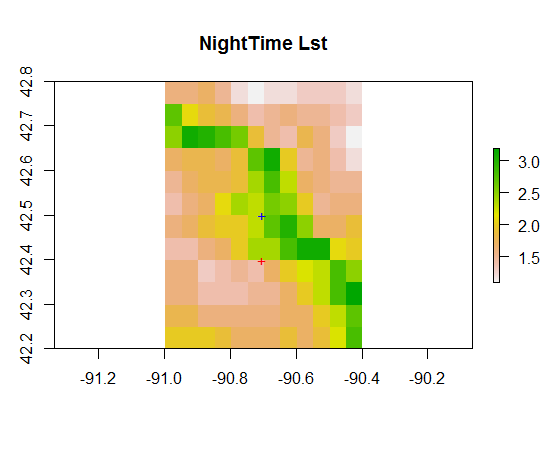Metadata Dubuque and UHI
Want to share your content on R-bloggers? click here if you have a blog, or here if you don't.
I’m in the process of remaking all the metadata from scratch and looking once again at the question of UHI. There are not any global conclusions we can draw from the data yet; I’m just in the process of checking out everything that is available that could be used to illuminate the problem. The problem, as I see it, is as follows. We know from numerous studies that UHI is a real phenomena. But, it’s far from simple. First lets get down to causes. The causes of UHI according to Oke are as follows. Note 20 + years of research has no expanded this list in any significant way
In the context of global temperature we are concerned with canopy layer UHI, that is UHI below the top of buildings where surface station thermometers are. Lets go through the causes one by one.
1. Increased absorption of short wave radiation. As Oke notes the construction of buildings adds surface area to the urban landscape. Building walls absorb SW radiation and the arrangement of building can lead to multiple reflection.
2. Increased LW radiation, primarily from air pollution over the city
3. decreased LW radiation from the surface. Skyview factor is critical here and skyview is directly related to the geometry of buildings. In a flat open plane free of building the surface has a clear view of the sky and can radiate accordingly.
4. Anthropogenic heat: this is excess heat from buildings and traffic. This is should be noted changes dramatically with the type of city and with latitude. The ranges of excess watts is rather large between city types.
5. decrease evapotranspiration: This results from changing the surface of the earth.
6. decreased turbulant heat transport. Again, building geometry plays an important roll here as does the local wind.
In addition to these variable that one can control when developing and urban area there are several that cannot be controled: the wind, clouds and nearby water.
With that in mind, let’s start to look at some metadata for Dubuque and its nearby airport. First a google map view
In the following charts the city pin will be marked witha blue cross and the airport with a red cross. In terms of incoming solar we should be aware that changes to evapotranspiration can cause changes in cloud cover. Looking at Modis cloud cover, we see the count for days of cloud cover. Less clouds is more sun.
Next we want to look at transformations to the surface. In the map that follows we have marked the urban built areas as Green bits
Next we look at population. There are a few good sources here: first is a 5 minute source for 2005 and after a 2.5 minute source for the year 2000
Next, we will look at daytime LST or land surface temperature.
And next we look at Night time LSt when UHI is supposed to be the highest
In case you are wondering what that long green patch of warmth is, it’s water.
A couple things are clear. A reader named sunshine suggested that perhaps cars from the city infected the airport with UHI. Looking at the data, the differences in temperature would seem more likely to derive from fewer clouds over the city, more built surfaces, and the higher population that created those surfaces. The surfaces hold heat and they appear to retard the formation of clouds, leading to more sunshine in the city than at the airport. And, it seems the nearby water is morel likely to modulate the temperature at the airport than anything else.
Funny. First “sunshine” thought it was “depopulation”. Then he surmised it was cars. In all of this there was no attempt to to verify a thesis, just random thoughts. Sunshine, appears to have his head where there is none. In any case trying to find a cause for cooling trends or a cause for warming trends, trying to find a UHI signal, isn’t a simple task of throwing up random thoughts. We know the causes. 20 years after Oke’s essay, the causes remain the same. The weight of the causes is critical. more on that later
R-bloggers.com offers daily e-mail updates about R news and tutorials about learning R and many other topics. Click here if you're looking to post or find an R/data-science job.
Want to share your content on R-bloggers? click here if you have a blog, or here if you don't.









